Once you get hit by the Bianchi virus it will never let you go. It’s like cupid’s arrow finding its mark and causing a Bianchi celeste explosion of cycling love. I have been a Bianchi fan myself for about 20 years now. My first Italian lady was a Bianchi Nirone 7 and my current one is an Oltre XR4 CV Disc Ultegra DI2. The design, the logo, the name, the colors,… they all have that mesmerizing effect. I suppose my passion for Bianchi will sound familiar to your ears and eyes. As a result, I deep dived into the Bianchi world and decided to write an extensive article about this beautiful Italian brand. I am happy to take you on my celeste journey and I hope you will enjoy it.

A pinch of Bianchi history
The early days
In 1885, Edoardo Bianchi, just twenty, began his activity as a bicycle manufacturer in a small shop in via Nirone 7 in Milan. Bianchi velofanatics will immediately recognize that name… via Nirone. Indeed, it is one of the names which has been used to name a series of popular Bianchi bikes. Edoardo Bianchi was a boy of just 20 who lived since his early childhood in the Martinitt Institute where he received an education in the field of mechanics. Initially, Edoardo Bianchi did not only manufacture bikes, but many other mechanical and motorized products. Because he was so grateful for what the Martinitt Institute had offered and educated him from the moment he started working he always allocated a percentage of the profits he earned to the institute.

During the early years, making bicycles was one of the many objects Edoardo Bianchi developed. However, Edoardo soon realizes that bicycles are precisely the means of transport of the future, those that can lead his company to success! So he begins to dedicate his focus on bicycles only, not the classic ones of those days, but for the first time with wheels of the same size and a frame completely made of steel.
The first innovations
His first innovations were to reduce the diameter of the front wheel, the lowering of the pedals and the application of the chain (which was recently invented by the French Vincent). The result was a true piece of safe bicycle art. He made a particularly stable bicycle, which did not require acrobatics to keep your balance.
Edoardo Bianchi then developed a model with smaller diameter wheels, almost identical. In 1888 then he added the invention of Scottish veterinarian Dunlop which resulted in one of the first bicycles with pneumatic tires.
The royal invitation & the first bicycle for women
It is precisely in this period that Edoardo is called by none other than the House of Savoy. In fact, the royals, especially Queen Margherita, absolutely wanted to learn to ride a bicycle and therefore they needed an expert in the sector to teach them. Upon a few encounters between the royal family and Edoardo, the Bianchi company becomes an official supplier of the royal house. The red Crusader emblem of the Savoy appeared on every Bianchi bike these says. Edoardo tested his bikes in the royal park of Monza and he was able to adapt the vehicle to the wide skirts of the time, modifying the frame and thus creating the first women’s bicycle.
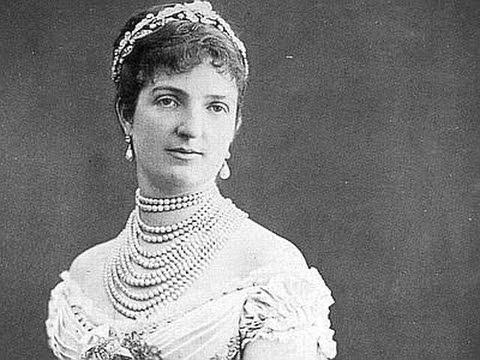
An era of early victories
It was 1895. In the following years Edoardo managed to obtain important and numerous awards with his Bianchi bikes, not only in Italy but also internationally. Bianchi bikes obtained victory after victory in many competitions. One of the most memorable is without doubt the 1899 victory of the Gran Paris Prix with Giovanni Fernando Tomaselli driving a Bianchi bike. But let’s also not forget the Giro d’Italia victory, with Carlo Galetti, in 1911.
Bianchi Celeste was born
1913 was the first time the typical Bianchi celeste color occurred. Known by all as Bianchi celeste, it is actually a shade of aqua green (or sky blue with shades of green) which slightly changed over the years. It was only around the 1940’s though the color became a distinct sign and true Bianchi characteristic.

An era of ground-breaking inventions
After developing the first bicycle foe women, In 1901 Bianchi presented the first bicycle containing a drive shaft. In 1913 he invented the front brake and by 1914 he became a successful manufacturer with impressive production numbers for that time producing 45,000 bicycles, 1,500 motorcycles and 1,000 cars per year.
An era of war
After the tragic events in Sarajevo, with Italy’s entry into the war, Bianchi transformed its production of civilian vehicles into military vehicles: motorcycles, trucks, cars and folding and rigid bicycles, adopted by the Ministry of War and by military institutions. With solid tires for the troops, with pneumatic tires for the officers, he developed a unique bike for to the Bersaglieri of the Royal Army. A bike which was used bot on and off-road, from the Alps (Caporetto, Piave area, Monte Grappa) to the African deserts: the first Mountain Bike was born.
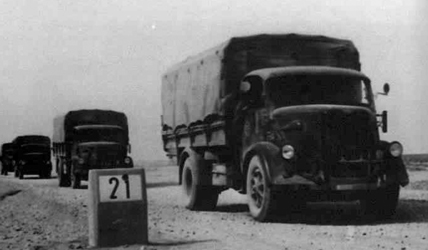
Another era of victories
Tommaselli’s first, other sporting successes followed regularly: Giovanni Rossignoli (1903), Giovanni Gerbi, the Red Devil (1905), Petit Breton (1907, winner of the first Milan – Sanremo), Dario Beni (1909, winner of the first stage of the 1st Giro d’Italia), Eberardo Pavesi (1911), Giovanni Cuniolo (1912), Piani (1917), Francesco Verri (1920), Cesare Moretti (1922, Italian track champion), Bob Spears (1922, road champion ), Domenico Piemontesi (1928), Alfredo Bovet and Giuseppe Olmo (1933), Aldo Bini (1939).
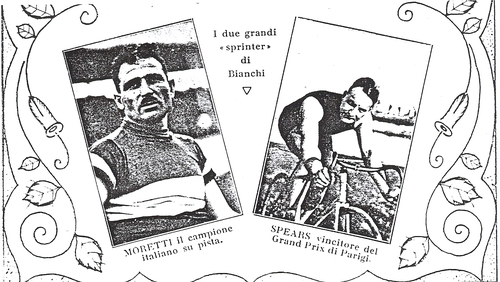
A Bianchi advertisement from 1925 read:
The Roman citizen was the citizen of the ancient world, the Bianchi machine is the machine of the modern world.
Bianchi bicycles, scattered all over the world, represent the summit of mechanical perfection, the summit of aesthetic beauty in every country, on every market. Each Bianchi bicycle is not only the most perfect machine from a technical point of view, but it is also the expression of the latest innovation.
The era of Fausto Coppi
In 1935 Bianchi was a flourishing company, absolute leader in the Italian market, producing 70,000 bicycles a year. But Bianchi also kept on supporting the cycling sport… and this resulted in a unique partnership between a big bike brand and a huge hero named Fausto Coppi. Both names will be linked to each other for eternity.

1940 Coppi won his 1st Tour of Italy.
1947 Coppi became World Pursuit Champion and won the 2nd Giro d’Italia.
1949 he won the Giro d’Italia then his 1st Tour de France.
The Chronicler’s sentence during the Cuneo to Pinerolo race is memorable and says it all:
“One man alone in charge,
his shirt is blue and white,
his name is Fausto Coppi “
In 1952 he won the Giro d’Italia and Tour de France again. In 1953 Coppi became world road champion and he won his 5th Tour of Italy.
His performances were unique, inimitable in terms of modality and style, becoming the subject of popular, literary and cinematographic stories.
The post-Coppi era of victories
1972 Marino Basso world road champion
1973 Felice Gimondi world road champion

1986 Moreno Argentin world road champion
1991 Bruno Zachi world MTB champion
1992 Gianni Bugno world road champion.
1993 Dario Acquaroli world MTB champion
1998 Marco Pantani wins both the Tour de France and the Giro d’Italia in the same yearand Marco Velo wins the Italian Time Trial Championship (he will repeat this in 2000).
Some other important Bianchi history dates
1980 the Bianchi name became part of the Piaggio Group.
1982 Bianchi launched the BMX in Europe; special bicycles made for off-road cycling, aimed at young people.
1984 the start of the Mountain Bike.
1987 Bianchi buys the Austrian brand Puch.
1997 Bianchi became part of the Swedish group Cycleurope AB, the world’s most important company in the cycling sector.
In 2006 Bianchi creates an exclusive range of Ducati Corse bicycles for the Ducati motorcycle manufacturer. The road racing bicycles and MTBs had an attractive design and were made of carbon fiber and an aluminum alloy with zinc and magnesium.
Current days and future
2014-2020 Bianchi became the sponsor of pro cycling team Jumbo-Visma. The Jumbo-Visma riders had the honor to cycle on 4 of their most popular models namely the Oltre XR4, the Specialissima, the Infinito CV and the Aquila CV. The cooperation between both brands has clearly been a success formula. During the past years Bianchi and Jumbo Visma won tens of professional races among others the Strade Bianchi, several Tour the France stages, the Vuelta, several national championships, Liège-Bastogne-Liège and so on. Cycling heroes like Wout van Aert, Primoz Roglic, Dylan Groenewegen and Tom Dumoulin have all praised the performance and technologies of the Italian celeste brand. No wonder, Team Jumbo Visma was granted the award for best cycling team of 2020. Bianchi for sure contributed a great deal to that success of the team. A successful period and partnership which unfortunately comes to an end in 2020.

2021-… Bianchi starts a partnership with professional cycling team Mitchelton-Scott.
Some iconic Bianchi Retro bikes
Vintage white bicycles from the 1930s
There are many 1930s Bianchi models which are quite popular as vintage retro bikes. The most popular ones are probably the Saetta and Bovet.
The 1933 Saetta model is one of the retro favorites because it is not only aesthetically very attractive and technically flawless, but also because it is a rather rare model. It was produced in commemoration the company’s 50th year of production. The color pattern consists of the classic white and light blue color with the red arrows, which will become typical of Bianchi bikes a few years later.
The Bovet model dates back to 1934. It was a road racing bike that consisted of some avant-garde features for that time. Among the most interesting features of all was the extra light construction, which gave the bicycle a better handling and which allowed to more easily reach high speeds.
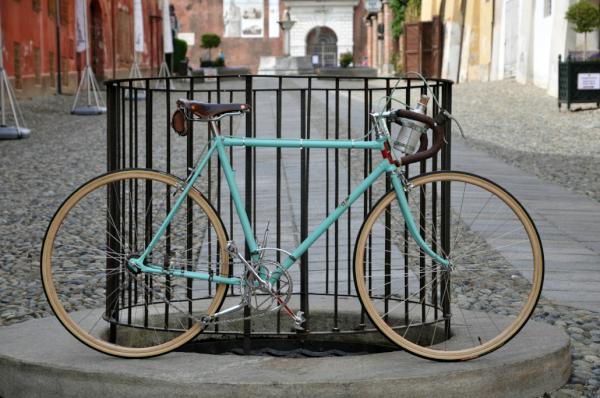
Folgore and Folgorissima: the two most important Bianchi bike models of the 1940s
Among the Bianchi models of the 1940s the Folgore model catches our attention. It went into production in 1939 and was produced until the late 40’s. It is one of the most important and iconic Bianchi racing bikes ever. This model had a weight of 12 kilograms and was fitted with a Campagnolo two-lever gearbox.
In 1949 the Folgore model was replaced by the new Folgorissima model. In 1950 Coppi won Paris-Roubaix on a Bianchi Folgorissima. From that moment onwards the name changed from Folgorissima to Paris-Roubaix. One of the most important features of this bicycle model is that the seat post is no longer located above the top tube, but at the rear.

Bianchi bicycles from the 1950s
When looking for 1950 Bianchi bike models the one to watch and buy is the Tour de France model which was released after Fausto Coppi’s Tour de France victory in 1952. It had a Campagnolo rear derailleur and wired derailleur series. Worth mentioning is also the World Champion model, which came on the market after Fausto’s victory in Lugano in 1953.
Towards the end of the 1950s, in 1958 to be precise, Bianchi started producing the Specialissima; a model which was in the 1960s by the Salvarani cycling team. The Specialissima was an exclusive and rather expensive bike those days.
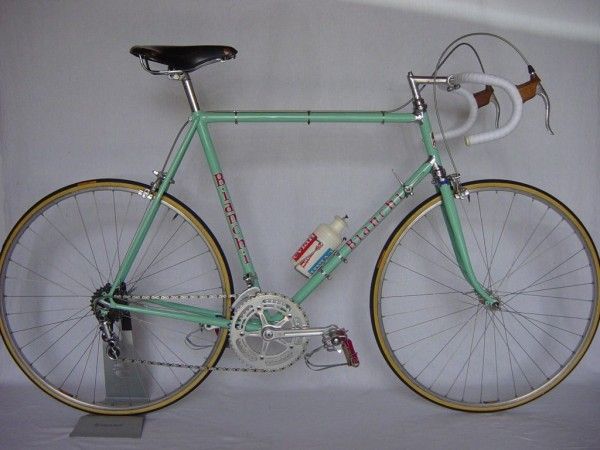
The most popular Bianchi retro cycling jerseys
- The bianchi-Ursus wool cycling jersey (1949-1950)
The Bianchi Ursus wool cycling jersey is a popular jersey amongst retro cycling fans and Bianchi lovers in general. Bianchi Ursus was a cycling team which only existed for one year (1949-1950). The fact it only existed for one year, makes the jersey even more popular because it shows you are a tue Bianchi fan. Only the real fans will recognize, adore and admire this Bianchi retro jersey. What makes it even more popular is the fact Fausto Coppi and his brother Serse Coppi both were part of the team. Other famous Bianchi Ursus cycling team members at that time were Oreste Conte, Fiorenzo Crippa and Désiré Keteleer. During this 1-year period Coppi won Paris-Roubaix, Roma-Napoli-Roma and la Flèche Wallone. Conte also won a few stages in the Giro d’Italia.

- Bianchi-Campagnolo retro cycling jersey (1973-1977)
A second poular Bianchi retro jersey is the one of Bianchi-Campagnolo. Bianch sponsored this cycling team between 1973 and 1977. The team consisted of amongst other the 1972 World Champion Marino Basso and the one and only 1972 Italian champion Felice Gimondi. During this 5 year period Gimondi won the Giro d’Italia in 1976 and the team won several other stages in the Giro d’Italia, stages in the Tour the France, Tirreno Adriatico, Gran Piemonte and de Giro di Puglia.

- Bianchi-Pirelli retro cycling jersey (1951-1959)
No wonder our top 3 of most popular Bianchi retro cycling jerseys ends with another Fausto Coppi jersey. The link between both in undeniable and everlasting. The 1951-1959 Bianchi-Pirelli period was one of the most successful in Bianchi history. Not only the legend himself Fausto Coppi but also Jacques Anquetil were part of the team during this period. After winning the Giro d’Italia in 1947 and 1949, he added two Giro victories to his list in 1952 and 1953. Besides he also won the Tour de France in the same Bianchi-Pirelli cycling jersey in 1952. He became the first cyclist to achieve this glorious Tour de France – Giro d’Italia double.

- Mercatone Uno – Bianchi retro cycling jersey
Last but not least there is an honorable mention for the Mercatone Uno – Bianchi cycling kit! Especially the Marco Pantani period was a very successful one for this cycling team. Marco Pantani, nicknamed il Pirata and Il Elefantino won both the Tour de France and the Giro d’Italia in 1998. Other famous team members during this period were Stefano Garzelli and Dmitri Konysiev. The cycling outfit is well-known and popular thanks to the unique yellow color with Bianchi celeste accents.

Little quiz question for the real Bianchi lover. Do you recall which bike Pantani rode during his Giro and Tour victories?
Indeed, the Bianchi Mega Pro XL Reparto Corse. A full aluminum bike of which the frame only weighs 850 grams; which was very exceptional in those days. A real piece of art!
Bianchi Cycling Clothing
We all know Bianchi is much more than just their bicycles. 130 years of history has resulted in bicycles, motor bikes… yes, even cars. The Italian brand has a huge fan base all around the world. These fans are always on a quest for new Bianchi accessories and clothing. Often because they are just in love with the heavenly and typical celeste and the retro nostalgy linked to the brand. To make the circle complete Bianchi partnered with cycling clothing manufacturer MOA Sports to design and develop their own famous and honored cycling clothing brand: Bianchi Milano. MOA Sports not only manufactures Bianchi clothing but also represents the likes of other famous bike wear brands like Nalini. Buying Bianchi Cycling clothing, you can therefore rest assured you are not only buying eye-catching bike apparel but also high-quality and high performance bike wear.

Bianchi Milano Celeste: heavenly blue with a touch of green
If there is one term, one color and one aspect which defines Bianchi; then it’s Celeste. The heavenly blue color with a pinch of green which melts together as Bianchi Celeste. When I see this color the first thing that goes through my mind is Bianchi. The second and third thing also by the way. No wonder Bianchi Milano shares that same love for this world-famous color. Even if it’s only a logo, or a colored mesh panel or a small zipper detail… each and every Bianchi Milano bike wear piece has at least one Celeste wink. The Bianchi Milano bike apparel is in most cases a colorful combination of celeste green, black, white and the colors of the Italian flag (green, white, red). Once in a while they add to it some other colors like pink, yellow or blue. But these are rather exceptions.
The Bianchi Milano collection consists of cycling clothing for both men and women. Next to the typical colors the bike wear also contains subtle details which refer to the Italian flag and the Bianchi eagle. All in all, the combination of colors, logos and the Italian flag give the brand a retro look and feel. Wearing Bianchi clothing you immediately feel like Fausto Coppi hitting the steep slopes of the Stelvio or the Gavia. It is pure nostalgy! The subtle details like pink, yellow and blue also make their cycling kits perfect to wear as a couple. Matching cycling clothing for men and women which differs in its subtility. Imagine a complete cycling team wearing the same Bianchi celeste bike wear… it’s like a fata morgana of thousand and one nights turning into reality. A dream come true!
Bianchi Milano: innovation, technology and creativity
We could summarize Bianchi Milano as bike wear brand in 3 simple words: Innovation, technology and creativity. The creativity part we have already discussed in our previous chapter. That creativity results in an unparalleled retro look. Retro in this case doesn’t mean old-fashioned. The Bianchi Milano brand namely is a perfect example of how innovative technology and a retro look can still result in high-quality performance apparel.
In additional we are big fans of Bianchi Milano bike wear because of the large rear pockets and the reflective details which increases our visibility on the road.
MOA Sports uses the best of the best fabrics to create their Bianchi Milano jerseys and bib shorts. Their fabrics have a high breathability, are quick drying but at the same time are body tight to ensure a comfortable feeling and an aerodynamic appearance. The elastic microfiber and laser cut seams ensure your drag is reduced to the absolute minimum.

The Bianchi Milano Collection
Bianchi Milano offers a wide range of cycling clothing and cycling clothing accessories. Besides the typical short and long sleeve jerseys and bike shorts with or without straps, the brand has much more to offer. Leg warmers, arm warmers, cycling caps, gloves, socks, winter cycling jackets, rain jackets and even shoes. You name it and they have it. A complete matching Bianchi cycling kit…sometimes celeste dreams can come true!
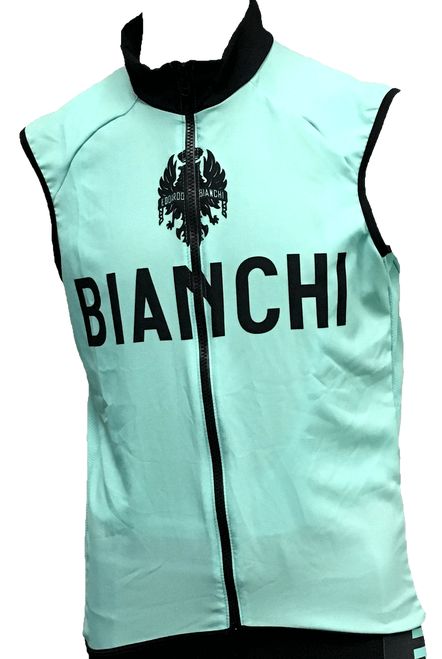
Bianchi Milano: appearance matters
We all recognize those Bianchi celeste cycling kits from miles away! The celeste armada… eye-catching, magic, dazzling, amazing…no adjective can describe the feeling when we see our beloved bike apparel. Bianchi Milano knows appearance matter but also knows you are looking for bike apparel to perform. Their extended bike wear collection for men and women, yes even for children, has all it takes to be your partner in cycling crime during your next ride.
Where to buy Bianchi cycling apparel
If you are looking for the current Bianchi Milano bike apparel we can recommend the following online shops:
- Bobshop (German webshop in different languages) – Worldwide shipping
- Albabici (US – Find a local dealer which sells Bianchi apparel)
- Bikeattack (US Webshop and store) – Worldwide shipping
- All4cycling (Italian webshop and stores) – Worldwide shipping
Are you looking for the retro cycling jerseys? Bianchi also released their own retro vintage look collection. You could also give it a try by vsisting one of the below vintage cycling clothing websites:
- Steel Vintage (UK Online shop) – Worldwide shipping
- Albabici (US – Find a local dealer which sells Bianchi apparel)
- Bikeandrun (UK Online shop)
- Prendas (UK Online shop) – Worldwide shipping
Keep on riding your Bianchi my dear velofanatics friends!
Things you probably didn’t know about Bianchi
The name Bianchi will probably ring a bell. Some will even know that Bianchi is undeniably linked to Bianchi celeste green and even to Marco Pantani and Fausto Coppi. Others will still recall how Jan Ullrich won the Tour de France on his Bianchi. But did you know Bianchi also made motorcycles? Or did you know Bianchi was an official Royal bicycle supplier? To end this Bianchi article, we are sharing some things you probably didn’t know about Bianchi. Enjoy and be surprised ?
It is the oldest bicycle manufacturer in the world
Bianchi was founded in 1885. Since then it has been manufacturing bicycles without interruption. This makes the brand the oldest bicycle manufacturer in the world of all those still active on the bike market.
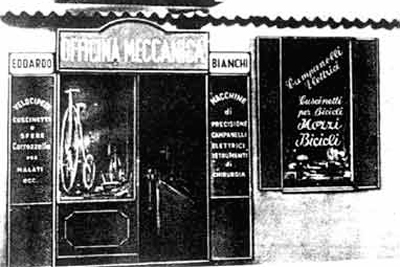
70 years of motorcycle production
Although the main activity of the brand since its founding was bicycles, Bianchi also produced motorcycles. Not for a few years, but for 70 years in a row. In 1897 namely they opened a separate production line for motorcycle production which remained active until 1967. In 1967 the brand stopped its automotive division. Between 1925 and 1930 the Bianchi motorcycles were quite successful in motorcycling racing, winning a.o. a European championship.
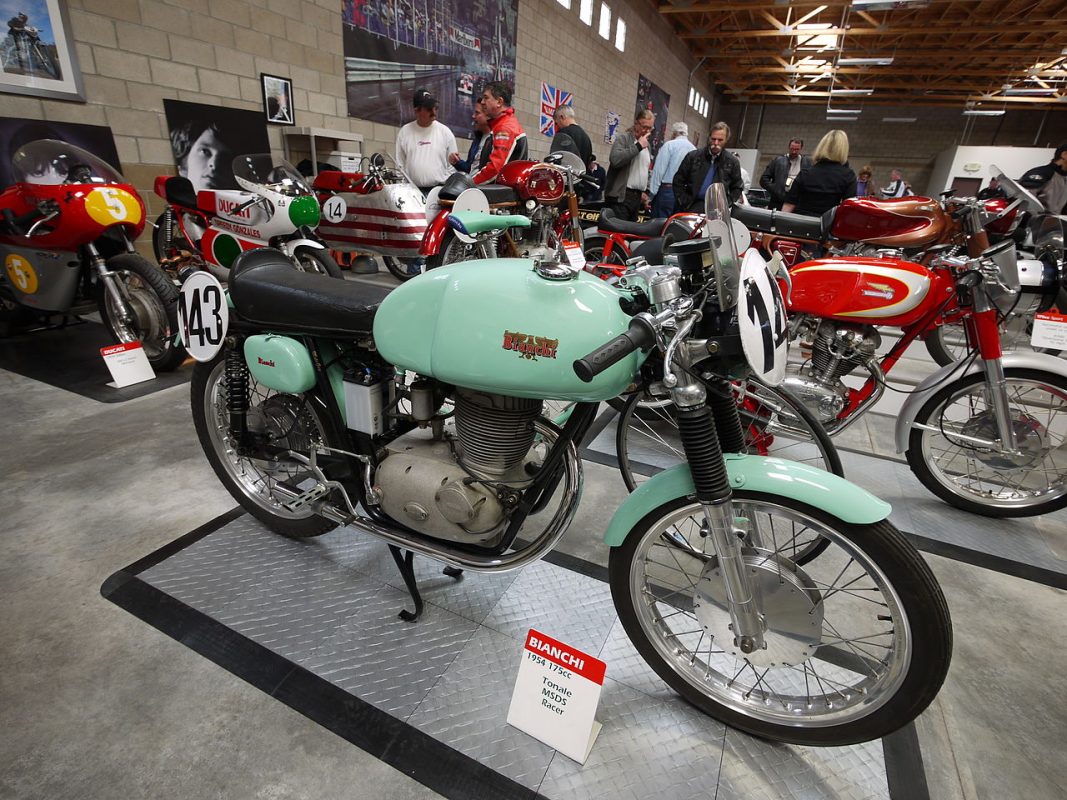
Bianchi produced trucks for the Italian army
In 1901 the founder of the company, Edoardo Bianchi, started to produce cars. This is how in 1903 the first Bianchi automobile came onto the market. In the 1930s he also began producing trucks at his factory. In fact, Bianchi became the supplier of trucks for the Italian army during World War II.
At the end of the war, it closed the automotive division because its factory had been bombed during the war.
Its Via Nirone 7 model is named after the street where the brand was born
One of Bianchi’s most representative bicycle models is Via Nirone 7. It is named after Bianchi’s first workshop which was located at 7, Via Nirone in Milan.
Bianchi is one of the most counterfeit brands in the world
Bianchi bicycles have become real collector’s items. That is why it is one of the most counterfeit brands in the world. The company has a department dedicated to fight counterfeiting. Each year, more than 4,500 online auctions are aborted because unauthorized replicas and counterfeits of Bianchi are put up for sale.
Bianchi was the brand that invented the front brake and drive chain
Bianchi launched some great innovations in the world of road cycling. The first important one was the use of wheels with tires of the same diameter. Until then it was common for the front and rear wheels of bicycles to be of different sizes. Additionally, Edoardo Bianchi adapted John Boyd Dunlop’s idea to replace solid wheels with inner tube tires.
The second major technological innovation was the introduction of front rim brakes. Even today this braking system is still commonly used in road cycling and has remained unchanged until the recent introduction of disc brakes.
In 1901 Edoardo Bianchi patented a transmission system that connected the pedaling force to the rear wheel through a chain. It was the start of the modern cardan transmission system.
Edoardo Bianchi first produced medical utensils
Edoardo Bianchi opened his first bicycle workshop at the age of 21. Until then he was engaged in a totally different activity: he manufactured medical instruments. His knowledge of the industrial design of mechanical tools helped him later on to apply the same principles to his bike manufacturing.
In 1895 Bianchi created the first bicycle for women
Currently, the Bianchi bicycle versions for women are called Dama Bianca. Edoardo Bianchi was one of the pioneers in the design and production of bicycles with a specific frame geometry for women.
In 1895, following the success of his bikes in Italy, Queen Margaret summoned him to the Palace of Monza to teach both her and the king to ride a bicycle. Edoardo Bianchi took the opportunity to design a bike frame that was compatible with the enormous skirts that women wore at that time. His analysis and research resulted in the first bicycle for women.
The Italian Royal Household was the official bicycle supplier
In 1895, King Umberto of Italy decided to make Bianchi official supplier of the Royal Household. This distinction entitled the brand to use the coat of arms of the House of Savoy. For some years this became the Bianchi bicycle logo. Only afterwards the current eagle symbol replaced the coat of arms. Nevertheless, there is still a subtle reference to the royal family in the logo. The eagle is namely a crowned eagle.
Bianchi invented the first folding mountain bike in 1915
In 1915, the Italian army commissioned Edoardo Bianchi to make a bicycle that soldiers could use to ride on dirty and stony roads and terrain. Bianchi then designed a special model that had wider tires, suspensions on both wheels and a system to fold the frame. In this way the soldiers could fold the bicycle and carry it in their backpack.

The Royal Italian Light Infantry used this bicycle during the First World War. It was the first version of our current mountain bike.
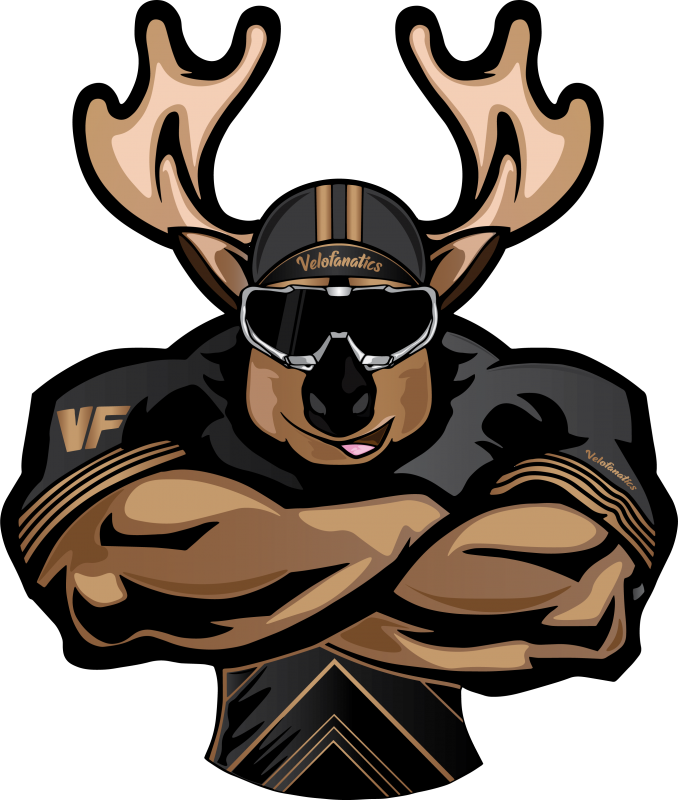




Been a bianchi fan for ages! 🙂
Wonderful to meet Bianchi soulmates 🙂
Been a retro cycling fan for a while. Already read your retro cycling jersey article and now this one… super!
Thanks a lot Dennis! Means a lot to me…
What an extended Bianchi article…love it…from the first to the last letter 🙂
Thanks a lot Sara. Much appreciated.
Very well written…thanks for sharing this.
Excellent article – just one tiny tweak – the model that followed the Folgore is the Folgorissima (Super Lightning), not Folgorissimo. Thanks for what you do 🙂
Hi Dave, thanks for the feedback. My apologies. I have corrected it in the article. Have a great weekend! Wim
I got an original bicycle Bianchi- VIA NIRONE 7- it’s great for my rides 🚴🏻♂️..👍😜👀
Nice information, I got an original bicycle Bianchi- VIA NIRONE 7- it’s great for my rides 🚴🏻♂️..👍😜👀